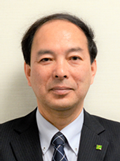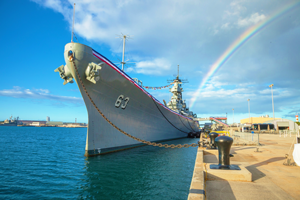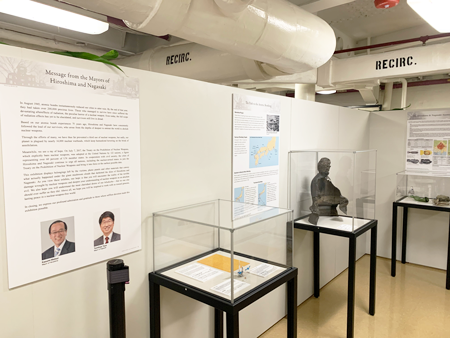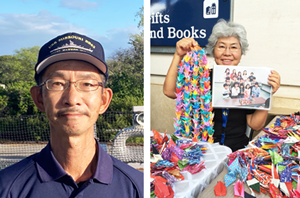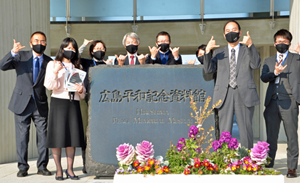From August 13, 2020 (75 years after the atomic bombing) to February 27, 2021 (80 years after the start of the war between Japan and the United States), the Hiroshima-Nagasaki Atomic Bomb and Peace Exhibition was held at the Battleship Missouri Memorial in Pearl Harbor, Hawaii, the site of the start of the war between Japan and the United States.
Twenty A-bomb artifacts and thirty panels explaining the reality of the atomic bombings of Hiroshima and Nagasaki were displayed to convey the actual damage inflicted by the atomic bombings.
Battleship Missouri Memorial
In September 1945, around four years after the outbreak of war between Japan and the United States, the ceremony for the signing of Japanese Instrument of Surrender was held on the Battleship Missouri.
After being decommissioned, the Missouri was docked at Pearl Harbor in 1998, and was opened to the public the following year as the Battleship Missouri Memorial.
Battleship Missouri Memorial (photograph provided by Battleship Missouri Memorial)
The highlights of the ship include the deck where the signing ceremony took place, the 16-inch main gun, and the Wardroom in officer's Country.
Visitors can also see the Kamikaze Deck, the site of the Kamikaze suicide plane crash.
In April 1945, during a battle off the coast of Okinawa, a suicide plane plunged into the starboard stern area of the ship, causing a fire.
After the fire had been extinguished, the body of a suicide attacker was found on the deck, with only the upper half of his body remaining.
The crew tried to quickly dispose of the body, but Captain William Callahan said, "Now that he is dead, he is no longer our enemy, and we should respect his actions in fighting for his country. He shall be given a military burial at sea."
The next morning, with many crew members watching, the burial at sea took place.
The crash site was not repaired and remains intact.
Exhibition held during the pandemic
Due to the spread of the COVID‑19, the Exhibition was held amidst some confusion.
First of all, the exhibition started on August 13, 2020, approximately one month later than originally planned, and the A-bomb testimonies, which are usually given on-site at the A-bomb exhibitions, were given online from Hiroshima on August 21.
Immediately after this the infection spread again in Hawaii, and for this reason the Battleship Missouri Memorial was closed from August 27.
Venue of the A-bomb exhibition (photograph provided by Battleship Missouri Memorial)
I spent many days in confusion in Hiroshima, wondering what would happen next.
Every day, as soon as I arrived at work, I opened my computer to check the current situation in Hawaii.
It took some time to get the situation under control, and the museum eventually opened on December 16, just before the end of the year.
Although the museum was open only four days a week, we were able to extend the exhibition period, from the original plan ending at the end of November, to February 27, 2021.
I felt like I had somehow managed to climb up from rock bottom.
Visitors' reactions
The A-bomb artifacts and panels were displayed under the title "Of Silhouettes and Ash: The Atomic Bombings of Hiroshima and Nagasaki", together with Sadako Sasaki's paper cranes, which the Battleship Missouri Memorial Museum had received from her family in June 2019.
There were around 13,500 visitors to the exhibition, half of whom were in their 20s or younger.
The main results of the questionnaire survey are indicated below.
I believe that the exhibition adequately conveyed the reality of the atomic bombing.
〇 After seeing this exhibition, how did you find the contents?
83.8% responded that the content was understandable.
Combined with the 13.1% who said it was "somewhat understandable", the total was 96.9%.
〇 To what extent did this exhibition help you deepen understanding about the A-bomb and the damage it caused?
66% responded that it deepened their understanding very much, 25.8% said "to some extent", and 6.2% said "a little", for a total of 98%.
〇 How much did this exhibition help you understand the importance of nuclear disarmament?
58.2% responded that they gained understanding very much, 30.8% said that they gained understanding to some extent, and 4.4% said that they gained a little understanding, for a total of 93.4%.
More than 90% of the respondents had a greater understanding of the atomic bombing, its damage, and nuclear weapons.
〇 Please provide any opinions or comments.
"I think it is important to know the damage caused by A-bomb in order to understand the history."
"It is important to remember and show the past as it occurred in history not as we wish it was. We must never forget."
"I wish there were more exhibits."
These are some of the comments that were provided by visitors.
Message from Battleship Missouri Memorial
Mike Carr, President and CEO
The Battleship Missouri Memorial hosted a brand-new traveling exhibit paying homage to those who lost their lives and loved ones in the 1945 Hiroshima and Nagasaki bombings.
This special display really gave Mighty Mo visitors a sense of the strong ties and partnership between Japan and the United States.
We are thankful for our partnership with the Hiroshima Peace Memorial Museum and cities of Hiroshima and Nagasaki for sharing their artifacts with us so that the Battleship Missouri Memorial could showcase such remarkable stories and commemorate a significant time in history through its "Of Silhouettes and Ash: The Atomic Bombings of Hiroshima and Nagasaki" exhibit.
Heidi Mooney, Tour Guide
I was so thankful to have the opportunity to view the traveling Hiroshima/Nagasaki exhibit that was temporarily at the USS Missouri Battleship.
I lived in Japan for many years, but never made it to Hiroshima or Nagasaki.
There were many aspects of the Atomic Bombs that were revealed to me through this exhibit; things I didn't know previously.
Thank you for working to educate others about the dangers of atomic warfare.
Online event linking with Hawaii
Even after the Hiroshima-Nagasaki Atomic Bomb and Peace Exhibition concludes, we will continue to work together with Battleship Missouri Memorial to pass on experiences of war.
As part of this effort, on July 10, 2021, Battleship Missouri Memorial and Hiroshima Peace Memorial Museum co-hosted an online event on the theme of "Communicating the Memories of War and Sowing the Seeds of Peace", where we listened to the stories of two people living in Hawaii.
Atsushi Maeda (left), Hiromi Peterson (right)
Mr. Atsushi Maeda, a native of Kochi Prefecture, Japan, who moved to Hawaii in 2005, has been serving as a tour guide at the Battleship Missouri Memorial since then.
He told us about the Battleship Missouri and his thought that "peace is not something we can take for granted, but is actually something we are very blessed with and must cherish."
Ms. Hiromi Peterson is a second-generation A-bomb survivor from Hiroshima City and a former high school teacher who has been involved in peace activities for many years.
She spoke about her family's experience of the atomic bombing, the Sadako Project at Pearl Harbor, and the development of human resources who can take action to achieve peace.
She said "Let each one of us be a person who thinks and acts for peace. If we all do something small, society will change a little."
The event was attended by 267 people in Hiroshima, who provided the following comments: "It was a really valuable opportunity to hear the real voices of people who live and work in Hawaii. Their honest words touched my heart," and "Their perspectives on Hiroshima and Japan from overseas were very refreshing to hear, and I realized that there are still many issues that need to be addressed."
We also received many requests to hear about museums overseas that have held A-bomb exhibitions.
Support in Hawaii
Hiroshima's immigration to Hawaii began in earnest in 1885.
Hiroshima City formed a sister city relationship with Honolulu in 1959, so the two cities have a long relationship.
The City of Honolulu and the Honolulu Hiroshima Kenjinkai provided enthusiastic support for the holding of this Atomic Bomb and Peace Exhibition, including PR activities for the citizens of Honolulu.
Masks received from Honolulu-Hiroshima Kenjinkai
Initially, it was planned to hold an A-bomb panel exhibition at the Honolulu City government office and have face-to-face testimonies by members of the Kenjinkai, but these were cancelled due to the coronavirus pandemic.
While this was very unfortunate, we were able to create new connections between Hawaii and our museum, such as when the Honolulu Hiroshima Kenjinkai sent us masks to help prevent infection in March 2021.
The Atomic Bomb and Peace Exhibition was significantly affected by the coronavirus pandemic sweeping the world, and I would like to express my gratitude once again to everyone involved for their enthusiasm and support, which enabled us to achieve various results under these adverse circumstances.
(August 2021)
